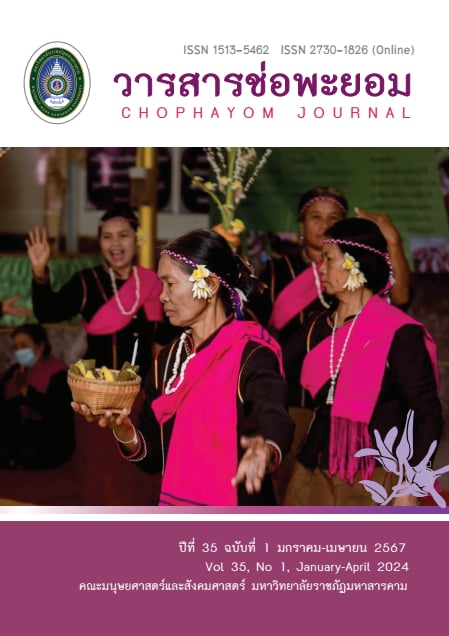From Silk Traditions of Ancient Kui People to Creation of Folk Dances Performance: 'Klaemor Kui Takhian
Keywords:
Folk Dance, Klaemor Kuy Takhian, Embroidering, CreativityAbstract
The objective of this research was to study the background of Kui people silk culture and the creating of traditional dance performance at Ban Takhian, Samrong Thap, Subdistrict Samrong, Thap District Surin Province. This was a qualitative research. Collecting data by non-participant observation, structured and nonstructured interview, and focus group. The data was analyzed by descriptive.
The results of the study found that Kui people silk culture was the wisdom of dyeing fabric from ebony. There were 8 steps in this process. Originally, it was only worn for rituals. Nowadays, we have made ebony-dyed fabric into shirts and skirts which integrated from traditional embroidery with modern knowledge in modern pattern design. Embroidery was added to clothings to be worn during traditional merit-making ceremonies in the village. In order to enhance the level of local wisdom, clothings with embroidered patterns in silk was used in traditional dancing performances which was called Galmoguitakhian. Galmoguitakhian created the dancing performance inspired by the study of the Ban Takhian Gale rituals. It was created for treatment. The ritual was consisted of 7 steps. The dancing were designed from the manners of the ancestor ghost which invited into the medium and also imitated the manners of elephants and horses in the forest. There were 55 dancing patterns that divided into 3 phases. The first phase was the situation of the patient who asked the medium to consider the symptoms and the treatment which consisted of 33 dancing patterns. The second phase was about the communication between the medium, the deities and the ancestor ghost that invited to dance in the holy place which consisted of 6 dancing patterns. The third phase showed the methods of treatment which consisted of 16 dancing patterns.
Keywords: Folk Dance, Klaemor Kui Takhian, Embroidering, Creativity
References
กรมศิลปากร. (2547). สุธนูกลอนสวด. กรุงเทพฯ: เอดิสัน เพรส โพรดักส์.
ชัชวาล วงษ์ประเสริฐ. (2532). ศิลปะการฟ้อน ภาคอิสาน. มหาสารคาม : สำนักวิทยบริการมหาวิทยาลัยศรีนครินทรวิโรฒมหาสารคาม.
ธีระพรรณ มีกุศล. (2559).พิธีกรรมเซ่นยะจู๊ชาติพันธุ์กูย บ้านตะเคียน อำเภอสำโรงทาบ จังหวัดสุรินทร์. (วิทยานิพนธ์ครุศาสตรมหาบัณฑิต สาขาวิชาสังคมศึกษา, มหาวิทยาลัยราชภัฏสุรินทร์).
สุมิตร เทพวงษ์. (2541).นาฏศิลป์ไทย: นาฏศิลป์สาหรับครูประถมศึกษา-อุดมศึกษา. พิมพ์ครั้งที่ 2. กรุงเทพฯ: โอเดียนสโตร.
สุรพล วิรุฬห์รักษ์. (2549). นาฏศิลป์รัชการที่ 9. กรุงเทพฯ: สำนักพิมพ์แห่งจุฬาลงกรณ์มหาวิทยาลัย.
สุรพล วิรุฬห์รักษ์. (2547). หลักการแสดงนาฏยศิลป์ปริทรรศน์. กรุงเทพฯ: สำนักพิมพ์แห่งจุฬาลงกรณ์มหาวิทยาลัย.
Downloads
Published
How to Cite
Issue
Section
License
Copyright (c) 2024 Chophayom Journal

This work is licensed under a Creative Commons Attribution-NonCommercial-NoDerivatives 4.0 International License.






